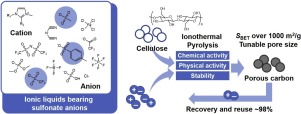当前位置:
X-MOL 学术
›
J. Anal. Appl. Pyrol.
›
论文详情
Our official English website, www.x-mol.net, welcomes your
feedback! (Note: you will need to create a separate account there.)
Influence of ionic liquid type on porous carbon formation during the ionothermal pyrolysis of cellulose
Journal of Analytical and Applied Pyrolysis ( IF 5.8 ) Pub Date : 2020-01-01 , DOI: 10.1016/j.jaap.2019.104728 Xin Huang , Kento Yamasaki , Shinji Kudo , Jonathan Sperry , Jun-ichiro Hayashi
Journal of Analytical and Applied Pyrolysis ( IF 5.8 ) Pub Date : 2020-01-01 , DOI: 10.1016/j.jaap.2019.104728 Xin Huang , Kento Yamasaki , Shinji Kudo , Jonathan Sperry , Jun-ichiro Hayashi

|
Abstract Ionothermal strategy using ionic liquid (IL) enables production of functional porous carbons at a low temperature from biomass and its components in one-step. However, despite diverse physicochemical properties of ionic liquids, there has been little understanding of the influence of IL type on reactions occurring in the pyrolytic conversion to carbon. In this study, 18 types of typical imidazolium-based ILs were screened in ionothermal pyrolysis of cellulose, where cellulose was mixed with IL, pyrolyzed, and then washed by a solvent for the removal and recovering of IL. The capability of IL for the porous carbon formation depended significantly on the type of IL and was reasonably explained by the hydrogen bond basicity. Among ILs tested, ILs with sulfonate anions showed the best performance in terms of the surface area of resulting carbon and IL recovery. The chemical interaction of IL with cellulose, caused by the moderate hydrogen bond basicity, facilitated the dehydration at low temperatures to form microporous carbon domains, and the presence of IL prevented the shrinkage of carbon framework. The surface area reached 1067 m2/g in the pyrolysis at 350 °C, which was the highest among ionothermally-synthesized carbons from biomass, reported so far. The function of IL, working as a pore template, enabled the control of pore size distribution over a wide range, e.g., carbons with a variety of total pore volume (0.33–1.13 cm3/g) and high surface area at a similar level (719–886 m2/g) were obtained by changing IL fraction in the mixture with cellulose within the range of 9–50 wt%. Furthermore, more than 90% of the IL could be recovered after pyrolysis, and the reuse led to a reproducible yield of carbon with similar pore sizes.
中文翻译:

离子液体类型对纤维素离子热解过程中多孔碳形成的影响
摘要 使用离子液体 (IL) 的离子热策略能够在低温下从生物质及其组分中一步生产功能性多孔碳。然而,尽管离子液体的物理化学性质多种多样,但对离子液体类型对热解转化为碳的反应的影响知之甚少。在这项研究中,在纤维素的离子热解中筛选了 18 种典型的咪唑基离子液体,其中纤维素与离子液体混合,热解,然后用溶剂洗涤以去除和回收离子液体。IL 形成多孔碳的能力显着取决于 IL 的类型,并且可以通过氢键碱性合理地解释。在测试的 ILs 中,具有磺酸根阴离子的离子液体在所得碳的表面积和离子液体回收率方面表现出最佳性能。由中等氢键碱性引起的 IL 与纤维素的化学相互作用促进了低温脱水形成微孔碳域,并且 IL 的存在阻止了碳骨架的收缩。在 350 °C 的热解中表面积达到 1067 m2/g,这是迄今为止报道的生物质电离热合成碳中最高的。IL 作为孔模板的功能可以在很宽的范围内控制孔径分布,例如具有各种总孔体积 (0.33–1.13 cm3/g) 和类似水平的高表面积的碳( 719–886 m2/g) 通过在 9–50 wt% 范围内改变纤维素混合物中的 IL 分数而获得。
更新日期:2020-01-01
中文翻译:

离子液体类型对纤维素离子热解过程中多孔碳形成的影响
摘要 使用离子液体 (IL) 的离子热策略能够在低温下从生物质及其组分中一步生产功能性多孔碳。然而,尽管离子液体的物理化学性质多种多样,但对离子液体类型对热解转化为碳的反应的影响知之甚少。在这项研究中,在纤维素的离子热解中筛选了 18 种典型的咪唑基离子液体,其中纤维素与离子液体混合,热解,然后用溶剂洗涤以去除和回收离子液体。IL 形成多孔碳的能力显着取决于 IL 的类型,并且可以通过氢键碱性合理地解释。在测试的 ILs 中,具有磺酸根阴离子的离子液体在所得碳的表面积和离子液体回收率方面表现出最佳性能。由中等氢键碱性引起的 IL 与纤维素的化学相互作用促进了低温脱水形成微孔碳域,并且 IL 的存在阻止了碳骨架的收缩。在 350 °C 的热解中表面积达到 1067 m2/g,这是迄今为止报道的生物质电离热合成碳中最高的。IL 作为孔模板的功能可以在很宽的范围内控制孔径分布,例如具有各种总孔体积 (0.33–1.13 cm3/g) 和类似水平的高表面积的碳( 719–886 m2/g) 通过在 9–50 wt% 范围内改变纤维素混合物中的 IL 分数而获得。











































 京公网安备 11010802027423号
京公网安备 11010802027423号